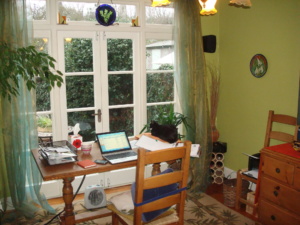Freelance! Glorious Freelance!
Time to read: 2 minutes
Sam Howard looks at how to survive and thrive on the freelance diet…

Most freelancers say they took this path to have a better quality of life. Most ex-freelancers say they gave it up because the feast and famine aspect was completely counter intuitive to achieving the work life balance they craved.
Ergo to sustain independence you need a strategy for coping with the Cabbage Soup Diet one week and the All You Can Eat Buffet the next. Here’s mine:
Feast: I love the pace, the focus, and the fear of The Feast! But this year, instead of doing my impression of an overworked Scrat and chasing down every last acorn, as the work ramped up I pulled in fellow freelancer experts to do the bits that they do best, leaving me to what I do best. Net result – very happy clients (several experts for the price of one) and several happy experts instead of one, which karmicly is a good thing right? In the short term slightly less acorns for me, but by delivering really good work (i.e. better than I could manage on my own) hopefully we planted a few metaphorical oak trees for the long term.
Famine: So I could stay in bed, stare at the ceiling and wonder if I haven’t completely ruined my career… or, instead I could actually look forward to the downtime and line up a load of projects designed to get out of the office, rest the brain and exercise the brawn. You might of heard the whoop of joy as I slammed down the lid of my laptop on 15th May, 10.45am. Over the coming weeks I finally redecorated the bedroom after nine years of dreaming in bloody magnolia. Net result – I swapped eight hours a day for a twelve but achieved an almost zen like mental status and when the ‘real’ work kicked back in, both client side and the house-keeping I returned to it quite refreshed and with rather shapely upper arms.
Regular meals: I struggle when, to my mind, there is not enough ‘real’ work to lace the day with the Fear – so I don’t do it at all. Instead I sand down the kitchen worktops. After several days of this, yes the worktops are very shiny but the real work has insidiously mounted up. The Fear has a genuine reason to be there and I’m in a self-induced state of work bulimia.
Grazing seems beyond me.
But at least if ever I do feel tempted to lay in bed, stare at the ceiling and ponder the vagaries of freelance – I can also admire the paintwork.
What price freedom? Part III: When to offer a discount
Time to read: 3 minutes
Third of three posts from Sam Howard on the commercials of freelancing: How not to give away your work as a PR freelancer:
The last two posts, looked at how to calculate your base rate ( how much do you need to charge to survive) and your ceiling rate, (what the market will bear).
Hopefully the first calculation is lower than the second one, if not please stop reading this now and use this time to send out your resume. You’re are not going to be able to make it work as a freelancer.This post briefly covers what factors to consider when contemplating discounting your work.
Reasonable reasons to discount
- Do you know the client? Sounds obvious but if you know them already, then proving you’re the right person for the job, aka pitching and then over-servicing, shouldn’t take too long as your immaculate reputation will proceed you. So the time you save in not going OTT in the early months can be passed on in a discounted rate for the same period. (not indefinitely)
- Do you know and like the client? By that I mean do you know that they are really easy to work with? That your judgement is valued, that the client will take risks, that emails can be six words long (and four of those spelled incorrectly), that decisions are made in real-time and it’s OK to vent rather than labouring over such a delicately worded email you might as well have crocheted it. (This is my idea of a perfect client, I concede you may have a different set of selection criteria.) If you have a perfect client, then treasure them, working with them is a pleasure and you’re rate should reflect that.
- Is it something that will help you grow? OK so moving into an adjacent sector, expanding your skill set, working with a client that you can learn much from, these are all reasons to invest in your portfolio and discount.( again just for a while say six months while you ‘come up to speed’).
Just double check the sum total of all these discounts isn’t lower than your basement rate and for every client you take on that skims or even dips below that rate you need to take one with a higher yield, remember this always has to be win/win.
Rubbish reasons to discount:
- You’re really broke: So you’re staring at your laptop, willing for that one email to arrive, that will put a smile on your face and some cash into your account. But when it comes, (and it will) think carefully about pricing. It’s so tempting to come in really low, ‘cos you’re desperate. But what does it say about the value of your work? As scary as it is, put in the right price, that reflects the skill and effort involved to do a great job. Yes, you may end up negotiating down, but no one ever gets to negotiate up.
- They’re really broke: Whether they’re those sparkly eyed start-ups or family friends, those customers that really, really want to work with you, but have no money… FYI they’re not customers, they’re window shoppers. So move them along and find someone to work with that can treat you with the respect you’ve earned. And with the money generated from real work for real customers you can afford to buy the sparkly eyed start-up or the family friend a pint – or three if they really do need your support.
- Discounted trial projects: Not convinced myself. You need to be hanging out with people that know how to be professional in business, after all you have to represent them. If they come across as timid amateurs to you then that’s how thy are going to come across to press.
Doing it for free
I hate working on the cheap, feeling like someone has got something over on me, de-valued my contribution – but I love working for free. One of the best bits about working for yourself, is being able to contribute your skills and expertise to a cause you believe in and make a small difference in the world. Maybe it’s providing your professional services to a cause, or painting fences or washing out kennels. But if you’ve managed your finances and time sensibly, then you can afford to give it away and come home with your pockets full of physic income and your conscience having had a spa day.Image courtesy of wallpaper.com
What price freedom? Part II Finding your ‘ceiling’ rate
Time to read: 3 minutes
Second of three posts from Sam Howard on the commercials of freelancing: Following on from my last post, which looked at how to calculate your bottom line day rate as a freelancer, this one looks at the ceiling day rate.

My child’s first bake sale, he was about seven and asked to make scones.
“How much are you selling them for?” I asked dispensing with the niceties.He hadn’t given it much thought, but guessed 10p each.
“Why?” I asked. He didn’t know.I told him to think harder. “OK cost of ingredients,” he said.
So how does that help the charity you are making them for? “OK cost plus 10p,” he said and so we discovered the concept of profit.
“So what about packaging and wastage?” So we got up to 30p. And he hoped that might be the end of it.
“But then,” I said triumphantly, “have you thought of what the market will bear?” He looked pretty annoyed at this point. “No”, he said, he had not.
Part 2 What the market will bear
So I explained what people paid for a scone in a nice tea shop at one end of the scale and how much you paid for a pack of scones in a low-end supermarket. We decided that if ours were fresh baked and prettily presented with a winning toothy smile, we might be able push that up to 50p a scone. It was a pretty successful bake sale by all accounts…
So what will the market bear for your services, given that you are not baking muffins, all proceeds are not going to charity, and that you’re probably not as cute as the average seven year old salesperson?
Local rate
First stop, so what are local freelancers charging? Do they compare to you and your skills? Make sure these are valid, long term freelancers/independents. It’s a competitive market out there, but if people are offering to work for ‘silly money’ like you see on the bid sites, are you really going to compete with them, what are you competing for? To see who can go bust first?
Agency equivalent
You need to understand what local agencies are charging. if you’re former agency this is a no brainer. If you’re not, then you need to do some research to try and understand where you map on to the agency hierarchy, don’t go on your old salary (probably higher) but more on your experience and responsibilities, here’s a very very rough guide:
- 1 -3 years PR experience – account exec: Support role – admin, research, supervised outreach, supervised content creation, no direct reports ( not sure this is a good time to go freelance myself unless you have very low out goings), reports to account manager.
- 3 – 6 years PR experience – account manager: Implementation role, heads up tactics, main outreach person, day to day client go to person, directly manages juniors, reports to account director. Possibly knows the account better than anyone else.
- 6 – 8 years PR experience – account director, lead role, heads up strategy, leads client relationships, oversees budgeting, heavily involved in pitching, manages account managers, reports to group account director/director. Tasked with making money.
- 8+ years PR experience – group account director, senior account director etc – same as above but entrusted with more clients, more accounts, bigger budgets, bigger teams, and some development initiatives, reports to director.
- 10+ years of experience – director, running division, sits on key strategic accounts, leads new business drives, develops new services/territories, leads team, responsible for financial health of division, runs P&L, reports to CEO. Tasked with making profit.
Once you can map your role to an agency hierarchy, find out the local day rates for this role. Then to my mind you don’t just round your rate down, but you slash it. You don’t have the group expertise or the combined reach of an agency, also you don’t have the overheads. I tend to charge under half as this makes me viable for agency work too.
The bitter pill
Now you compare your market research to your notional day rate If your notional day rate tops the market rates, you have a problem. Really why is any one going to hire you in this climate if they can tap into the same services and expertise elsewhere for less? And if you take on a loss leader project, there is only one of you, while you’re not making enough money, there is no one else to make any money at all. Every day you work at the ‘wrong rate’ only puts even more pressure on the other days to over price. You need to think long and hard about how you are going to make this work. Possibly this is not the right time in your career to go freelance, mayber you need more skills/experience, so you can charge a stronger day rate or you need to wait until there is a time in your life when you don’t need to earn quite so much (eg the mortgage isn’t making your eyes water, the kids day care bills aren’t making you wish you’d got a dog instead.).
The sweet spot
The sweet spot for a freelancer is having a low cost base and a high/in demand skills base. If your notional day rate is at the low end of the market rate scale, you’re looking at win/win, you can round up your notional rate, still be extremely competitive and know you are going to be earning enough to be able to sustain the freelance life over the longer term. Who knows perhaps you can develop a side line in home-baked goods too…
Next blog looks at the variables that allow you to tweak the day rate.
What price freedom? Part I How to find your ‘base’ rate
Time to read: 2 minutes
First of three posts from Sam Howard on the commercials of freelancing:
If you are good with words, I’ve noticed, sooner or later you need to get good with maths. The first of three posts looking at how to price up your freelance comms work.
A recent survey in PRmoment, showed that most freelancers charge between £200 and £500 a day. So where might you fit in? The next few posts share my ideas on how you decide what to charge. Hopefully useful if you are considering becoming a freelance comms consultant, starting out, or just sense your business model might be a bit broken.
Part 1: calculating a day rate AKA what do you need to charge to survive?
Step 1) What do you need to earn?
Did you really go freelance to become rich? Really? Most people I know have gone freelance to take back control of their lives, to be able to make their own decisions, to be there for their families and generally to feel like they are living a more balanced and healthier life. And in that sense we are all very successful, though none of us ‘rich’. So when you are working out what you need to earn, if you really want to be a freelancer, I doubt if it’s anything like what you used to earn. Do a monthly budget of what you can cope with, (you’ll be surprised freelance currency goes along way).
This gives you your base line figure of what you need to clear after tax. For easy maths’ sake lets say that’s a £1,500 a month so £18,000 a year. So how does that convert to a day rate?
Step 2) How many days in the year do you have to earn it? Answer: it’s not 365
Though this is where you start.
– Days in the year 365
– Less main public holidays 5
– Less weekends 104 (don’t actually schedule to work weekends)
– Less holidays/family/emergency days 25
– Less sick/jet lag/ hangover days 12 ( just being realistic)
– Days available to work 220 ( standard industry figure)
Now assume that 50% of that time you are not doing client work, either because there just isn’t any, or because you are working but not being ‘paid’ for it, eg admin, networking, training, research, marketing, pitching, preparing materials etc. That leaves 110 days to cover your budget, plus tax plus expenses.
Step 3) Not all that money is yours you know; provision for tax and expenses.
So sticking with our notional sum of £18,000 a year,
Plus expenses say 15% £2,700 ( if you are working from home, can easily be more if you are not),
Plus tax, say 25% £4,500.
So in theory you need to earn around £25,200, to give you £18,000 and meet that £1,500 budget.
Step 4) Calculating the notional day rate
So now just look at how much you need in total, and divide it by client days.
In our model that’s
£25,200 /110 days = £229/day notional day rate.
You’re welcome
Next blog: how does that compare to what the market will bear? Favourably we hope. After that, take a look at when to discount your work so that you find that sweet spot that keeps your clients happy and your finances healthy.
In the world of freelance, is it wrong?
#Is it wrong? Sam Howard shares her frelance ethical ponderings:

shh please don’t wake him…
1. Just in case he’s the only person you’re going to get to talk to all day, is it wrong to launch in with your most perplexing business issues, work fears, and brilliant new ideas while your 11 year munches on his morning porridge and does up his shoe laces?
2. To wear leg warmers and fingerless gloves indoors?
3. To pretend the web camera on your Skype call isn’t working when in truth it’s cos you look like shit and The Bloody Dog is jumping around in the background, trying to bury his Kong toy in the sofa?
4. To have full blown conversations with the rabbit, cat and dog in an effort to recreate those water cooler moments?
5. To have the fan heater and the central heating on at the same time?
6. To stuff dog treats in your brand new £40 sheepskin slippers, that were a Christmas present from your lovely mum, in an effort to keep The Bloody Dog amused for ten minutes, so you can reach your copy-writing deadline?
7. To eat your soup straight out of the pan and then give the carton and the pan to The Bloody Dog to keep him quiet for another five minutes?
8. To hang up on a conference call because you’ve just spotted The Bloody Dog has got the rabbit’s head in his mouth?
9. To top up your afternoon coffee with a large dose of Tia Maria? And then put its purchase against your tax expenses as ‘office beverages’?
10. To open the door to your child as he comes home from school, starving hungry, freezing cold and soaked through, with the greeting:
“Can you PLEASE take The Bloody Dog out! I have had him all day and he’s driving me frickin crazy. GO! NOW! GO!”
a day in the life of a PR freelancer
Time to read: 2 minutes
So what’s it like being a PR freelancer? Six months into freelancing Sam Howard on what a calm day looks like (the frenetic days you don’t want to dwell on):
 |
| So you guys with proper jobs have an expense account, gym membership, private healthcare oh and a salary… but I have a dog, and his name is Moby. |
7.15am: Alarm goes off, this is really annoying as now I’m my own boss I’m sure I shouldn’t have to get up while it’s virtually dark, it says so in the small print somewhere.
8.00am: Lasso the new pup and accompany my son to the bus stop, and then walk our new lab/mastiff puppy, a much longed for addition to the family. He is 18 weeks old and my reward for going solo, my bonus if you like.
10:00am: Team commute to office.
10:01am: Team settles in for the day: I fire up my shiny new laptop, (last one died without warning, great week that was) cat settles on desk, giant rabbit flops by french window, new pup flakes out on sofa. Drink coffee, review mails. The days of 200-plus mails every morning are thankfully no more.There’s a mail from a head hunter, ‘do I want to go permanent in a super high-profile new role?’ No thank you. Another mail from a journo friend, ‘would I like to do some PR consultancy for a small tech company he’s just met?’ Yes please. Check out Facebook, Twitter and my LinkedIn groups.
11:00am: Start with some essential admin, this takes easily an hour a day. Enter my receipts and raise a modest invoice. This still makes me ridiculously proud, as if I baked it myself or something.
11.30am: Okay, so now the day is free for actual work. What luxury! When I was agency side, in the end, I was lucky if I could find 20 minutes to sit still and ‘do’ anything at all. I enjoy being able to focus, turns out I am a starter finisher, who knew? This morning I write some client content. I like writing good job too there is alot of it when you go freelance. Then spend some time preparing a workshop I’m giving at the Taylor Bennett Foundation, tomorrow. After all if your time is your own, it’s quite nice to give some of it away I think.
1.30pm: Boy do I miss Pret, Itsu, Eat, Tossed. Stand by the fridge and finish last night’s leftovers, then take the pup out, he chases leaves, I laugh.
2.10pm: Spend afternoon reaching out to contacts in search of internship opportunities for my USC Annenberg post grad students. I love working with my Californian crew, hopefully I’m teaching them the gentle art of self deprecation while they’re teaching me to be nice – won’t kill me will it?
5.20pm: Welcome my son home. I had to return to full time work when he was only tiny, now he is 11 and this is the first time that I can open the door to him pretty much every day. The novelty has yet to wear off. Manage to fix my printer after a week of glaring at it, feel really rather smug.
6.30pm: Shut down office but brain is still ticking, it’s hard to switch off just like that, so take pup for a quick stroll, he rolls on the grass and i have to drag him on his back for 50 yards.
7.00pm: Hit the kitchen and prepare something gorgeous. Tonight we’re having smoked haddock on puy lentils with hollandaise and an apple crumble. Not bad for a school night.
This article first appeared in PRMoment http://www.prmoment.com/.
The fallible freelancer – a cautionary tale

turns out life is not a rehearsal, shame becasue this month has been a shambles
Time to read: 3 minutes
Sam Howard shares some freelance fall out…
Everyone who’s their own boss bemoans the roller coaster ride of being solo. Secretly I have always thought this could be avoided if one was just a little bit more organised and realistic. I believe I may have even posted helpful advice on the subject. But it feels like September has gone out of its way to prove I knew nothing. Nada. Zip…
Week 1
Spend week in US to kick off big project, been looking forward to this since May. I’ve kept things ticking over in the summer but made sure the decks were completely clear for this big kick off. I’m sensible like that.
Week 2
Return all geared up, spend a week organizing myself and putting systems and processes into place. File every last mail both ‘in’ and ‘sent’ so I can access everything easily once project is live.
Week 3
Monday: News from the US. Project cancelled for internal reasons, no notice, no warning. Spend day feeling a bit numb… I have no work. I check contract, there is no provision for cancellation at this level. Christmas is cancelled.
Rest of week: Tempted to spend rest of week navel gazing. But navel gazing doesn’t pay the bills, so tell myself to buck up and see this as an opportunity to work with new people doing new things. Spend rest of week reaching out to industry contacts and worthy causes to see if I can earn my keep or at least be useful. Submit super competitive quotes, agree some freebies. Garner enough interest to keep myself busy for the next month or so.
Week 4
Monday: News from the US. There’s been a rethink, Project resurrected! Tra la la Christmas is back on. But now diary looks a bit messy what with the other commitments I’ve taken on and what if those not so super competitive quotes come through now? Tempted to go for a long walk, it’s all been a bit emotional. But realise I’m now effectively a week behind schedule on the big US project, so better just get my head down and stay focused.
Tuesday: Beloved vntagelaptop crashes, no notice, no warning. I take it to local repair shop, “All the docs are backed up,” I say with a touch of swagger, I am after all a sensible freelancer. “I just need you to restore mail.” How hard can that be? My IT team at the agency could fix things like this in ten minutes. “I’ll wait.” I say, casually flicking open a copy of PR Week that I’ve had the foresight to bring with me.
The repair man slowly and carefully explains that Outlook does not live in the ether like Gmail or Hotmail it lives on the laptop, the very dead laptop.
I was aghast!
He went on to explain the raw data from the mail service provider will come through on to a new PC, not this one, obvs, but my profile is gone and with it, sent mails, appointments and contacts…
I gather up my traitorous laptop, my tattered dignity and slink out of the shop.
Wednesday: OK, still no need to panic I’m a sensible freelancer and I have gadget insurance bought especially for such an eventuality. Nice gadget insurance man says of course they can and will help me. They’ll post me a claim form, I must post it back, once they have that they will arrange collection of my laptop and try to repair it, if they conclude it cannot be repaired then they will go about sourcing a replacement to the value of a whopping £300.
Wow and in that time I could make myself a chocolate tea pot too, I’m sure that will be equally bloody helpful.
Thursday: Don’t have time to source an on line bargain, go to high street and pay lots and lots for a new laptop, whose price doubles by the time I’ve bought all the stuff I need to make it ‘go’. I can pick it up tomorrow.
Friday: Pick up sexy new laptop, and fire up Outlook – there in one very bulging ‘in box’ are all the emails I have ever received since going solo. But I have been severely humbled and for this unwieldy mercy I am truly grateful. Spend my birthday weekend working through ‘inbox ’reclaiming contacts and filing so I can have a clean start for Monday. Don’t sleep so good, as now two weeks behind on several projects. ( Er yes the stupid priced job did come in.)
Week 5
Monday: Printer breaks. Is it my aura?
Tuesday: New mail – Would I like to head up a big, new and exciting project, already a month behind, very labour intensive with very tight deadlines oh and it’s really rather lucrative? Hell YES!
This morning: Smart phone implodes. I fear I may be heading same way.
Ten tips for going freelance
Time to read: 3 minutes
It’s been six months since Sam Howard turned freelance. If you are contemplating ‘the big leap’ here are her early days tips, while the pain of learning them is still fresh:

the cat can stay but the table and the chair are going to have to go
1) Take a break before you begin: Contrary to what I was advised, I recommend you do not quit your day job on a Thursday and start your first contract on the Friday. I think I would have been more able to absorb the culture shock if I had allowed a month in between. Ideally a couple of weeks of doing NOTHING, after 22 plus years of ‘real’ work, I guess I could have cut myself some slack there. And then the next few weeks can be spent sorting out behind the scenes stuff and not just the paperwork but the basics like a comfy chair, stationary etc.
2) Apply some discipline to the financials: To quote Jessie J ‘it’s not about the money’. I knew that from the get go, but it’s quite tricky to unhook your real worth from your ‘take home’. Let it go, you are not your agency day rate or your old job title. You are so much more and being a freelancer gives you the space to explore it. But to avoid the feast or famine syndrome that everyone warns you about, set up a separate bank account, tip some cash in to it to ease yourself in, say three months of a notional wage. You’ll have enough to adjust to, without worrying about money from day one. Keep all your business outgoings and income in this one account, from this you can transfer an appropriate amount for tax into a savings account and also pull a regular wage so you can continue to budget as you did when you were employed.
3) Don’t underestimate how long tasks are going to take:One of the biggest shockers I found was that there was no one to whom I could delegate. I was so delighted that the decision making process was now instantaneous, but all the time savings made on that side were swallowed up by the implementation process now that it was just me to execute. I had to relearn skills I had abandoned years ago, like formatting, attention to detail, spelling…
4) Get out and talk to people: My first project was initially difficult and intense, that compounded with no team support or general water cooler chitchat meant I did feel overwhelmed at first. I quickly made a point of meeting an industry mate at least a couple of times a week to help keep my own trials and tribulations in context.
5) Dress the part: After a few months of looking like Bridget Jones in the throes of a messy divorce, I smartened up. For me the standard that works best is to dress as if you have a mild crush on the postman. Oh and you’ll have to schedule some regular exercise too, if you’re gonna have a chance with that postman.
6) Don’t be mean with yourself: I wish now I hadn’t bought a basic printer, trotting off to newsagents to pay for photocopies or coloured printouts, pains me man, it pains me. Also my dining room table is not the right height for a desk and sooner or later I am going to have to come to terms with this.
7) Find your natural rhythm: After so many years working Monday to Friday 9- 5 it’s natural to feel obliged to keep it up, but being a freelancer you can set your own rhythm. Mine follows the sun, if it’s sunny I do less, if it’s not I do more. Family commitments not withstanding, I’m happy to work in the evenings or weekends, if it means that when the sun comes out I can potter in the garden, keeping a squinty eye on the emails. Let go of the guilt. As long as you get the work done and it delivers above, beyond and ahead of your client expectations, then really you can please yourself when and how you do it.
8) Stay in the loop: Now you’re not part of the company chatter, you need to put extra effort into keeping up with what the industry is talking about and what’s trending. Make time in your daily schedule to read, comment and connect. Also go to conferences, training seminar’s etc, not just to network but to actually learn and assimilate.
9) Try to hold out for interesting projects:This has to be a huge plus of going freelance, work for people you like, take remits you enjoy. This is pay back for all those years of doing tasks to which you were painfully unsuited and having to work with people that normally you’d cross the street to avoid. You’ll end up doing such a great job you can easily widen the remit and referrals will surely follow.
10) Finally enjoy being nice to people! When you go freelance there are no power battles to win, no points to prove, no office politics to survive, you can just hang up your battered old ego and be nice. It feels great, really! And who knew people could be so responsive when you show some genuine consideration for their day and their challenges? Certainly not I.
The highs and lows of a fledgling freelancer
Time to read: 1 minute
A month into being a freelance PR and each day I lurch from dismay to delight – here’s a taster:

oh that chair looks really comfy..
High – first day, dancing around in my kitchen to Katie Perry ‘Firework’ deciding that was me, that was – a freelance firework.
Low – second day, no fireworks just housework which I never do but now don’t think I can afford for anyone else to do.
Low – first week, emailing myself to see if email was working (it was).
High – first blog, getting comments and being retweeted.
High – first client meeting, in a cake shop. Decided henceforth all client meetings shall be held in cake shops.
Low – first follow up, realising notes taken in said cake shop had to be actioned by me, and they take AGES!
High – office view, it looks out on to a snowdrop-littered garden with a giant rabbit hopping around in it. His name is Maximus.
High – office colleague, my desk has a cushion with a small cat on it. Her name is Lily. She looks at me with purry pride.
Low – office banter, turns out giant rabbits and small cats are not that great at office banter.
Low – office comfort, I just can’t get warm and the chair is wildly uncomfortable, I finish the day looking like a frozen Quasimodo.
High – office economies, my new printer was real cheap.
Low – false economies, my cheapo printer doesn’t photocopy I have to walk half a mile and pay 10p pay for one, so takes about 30 mins out of my day.
Low – office technology – still can’t get my Outlook to talk nicely to my HTC phone.
High – food, munching lunch while following the Archers (it’s all going on).
Low – food, my sandwiches are just not as nice as Prêt, nor is my coffee, I haven’t had a muffin in a month. I don’t know how to make sushi and don’t even mention Burritos.
High –food, lost two pounds in weight, go figure.
High – making decisions, making my own decisions and implementing them in the same 10 minutes is truly liberating.
Low – making mistakes, two hours later, realizing that half the time they are the wrong decisions is somewhat disconcerting.
What can I tell ya, it’s a learning curve…

